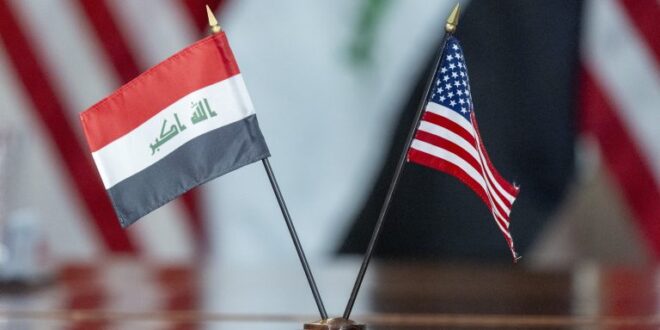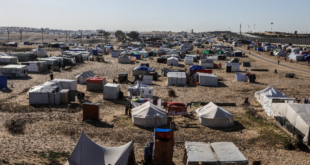The United States and Iraq reportedly have reached agreement to transition the U.S. military presence from leading an anti-Islamic State (IS) coalition to an enduring bilateral partnership.
The apparent agreement – the announcement of which has been delayed by the war in Gaza – reflects the Iraqi leadership’s belief that Iraqi forces can continue to suppress the Islamic State organization (IS) with less U.S. military support.
Some of the 2,500 U.S. military personnel will likely remain in Iraq in a long-term accord, primarily to counter Iranian influence in Iraq and the broader region.
The remodeled U.S.-Iraq strategic relationship signals Baghdad’s intent to continue to balance its relations with Tehran and Washington.
The U.S.-Iraq relationship has been undergoing re-evaluation over the past five years, since the March 2019 capture by U.S.-led forces of the Syrian town of Baghouz, the last bastion of physical control by the Islamic State (IS) organization’s “caliphate.” U.S. military personnel, who had been withdrawn from Iraq in 2011, were sent back into the country in 2014 to help destroy the group’s control over major portions of both Iraq and Syria. U.S. forces successfully helped Baghdad rebuild its beleaguered national forces that essentially collapsed at the hands of the IS offensive.
At the same time, the U.S. and Iraqi operations against IS required Iraq to recruit tens of thousands of mostly Shia militiamen organized as a formal arm of Iraq’s central government forces. In subsequent years, as the IS threat to Baghdad receded, the commanders of several pro-Iranian factions of the “Popular Mobilization Forces” (PMF), as the militias were termed, began to agitate to demand the U.S. withdraw its forces from Iraq entirely. Their stances, matched by occasional attacks on bases in Iraq where U.S. forces are deployed, echoed Tehran’s longstanding insistence that all U.S. forces should leave the region – and particularly from countries on Iran’s borders. Several Iraqi militia groups have received active Iranian support in the form of funding, weapons supplies, and direction from Iran’s Islamic Revolutionary Guard Corps – Qods Force (IRGC-QF), although it is unclear whether Tehran has been directly instigating their attacks on U.S. troops.
The government of Prime Minister Mohammad Shia al-Sudani, who came to power on the strength of votes from both hardline pro-Iranian as well as more moderate Shia voters and political leaders, has sought to balance Iraq’s relations with Washington and Tehran. Still, the war in Gaza, in which the overwhelming majority of Iraqis oppose what they perceive as unconditional U.S. support for Israel’s offensive against Hamas, has placed Sudani under growing pressure to reduce, if not end entirely, the U.S. military presence in Iraq. Compounding the internal political pressure on Sudani’s government has been the periodic U.S. retaliatory attacks on Iran-backed Iraqi groups that have escalated their rocket and other assaults on U.S. military personnel since the October 7 Hamas incursion into Israel. The Iran-supported attacks have been, to some extent, coordinated with other members of Iran’s Axis of Resistance that seek to punish and weaken Israel and the United States and, Iranian leaders hope, eventually push the U.S. out of the region entirely.
As the Gaza war dragged on without resolution, U.S. officials recognized the pressure on Sudani to distance his government from Washington. U.S. leaders sought to accommodate Sudani’s political needs while also preserving key aspects of the strategic relationship with Baghdad, including the need to prevent an IS resurgence. In January 2024, the U.S. and Iraq announced their “joint commission” had begun meeting to “end the Coalition in Iraq,” according to a statement from the Iraqi Prime Minister’s office. The statement added: “Military experts will oversee ending the military mission of the (U.S.-led) Global Coalition against Daesh [IS], a decade after its initiation and after its successful achievement of its mission in partnership with Iraqi security and military forces.” The statement implied the U.S. had agreed, in principle, to reduce its military presence in Iraq by transitioning the U.S. mission in Iraq from the lead force in the 87-nation “Global Coalition to Defeat ISIS” to an enduring, U.S.-Iraq strategic partnership. In April, President Biden and Prime Minister Sudani issued a joint statement affirming that they would review factors to determine when and how the mission of the Global Coalition in Iraq would end and transition to an enduring bilateral security partnership.
After eight months of negotiations, Reuters news agency, citing “multiple sources,” reported Friday that the U.S. and Iraq have reached an understanding on plans for the withdrawal of U.S.-led coalition forces from Iraq. According to the news agency, the plan has been broadly agreed but requires a final go-ahead from both U.S. and Iraqi leaders. An official announcement was initially scheduled for weeks ago, but was postponed due to regional escalation related to the Gaza war as well as to finalize some remaining details, according to Reuters’ sources. Farhad Alaaldin, foreign affairs adviser to Sudani, publicly corroborated the Reuters reporting, saying technical talks with Washington on the Coalition drawdown had concluded. He stated: “We are now on the brink of transitioning the relationship between Iraq and members of the international coalition to a new level, focusing on bilateral relations in military, security, economic, and cultural areas.”
The agreed plan would provide for hundreds of the 2,500 U.S. troops currently in Iraq to leave the country by September 2025, with the remainder departing by the end of 2026. The first phase of the drawdown would end one month before Iraqi parliamentary polls set for October 2025. And, the two-year time frame for the U.S. drawdown is intended to provide “breathing room” for potential adjustments if the regional situation changes, according to a U.S. official.
Presumably, other nations that together contribute hundreds of forces to the Global Coalition anti-IS mission – including Germany, France, Spain, and Italy – would also draw down forces from Iraq. Under the reported plan, all Coalition forces would leave the Ain al-Asad airbase in western Anbar province that has been subjected to repeated attacks by pro-Iranian militia groups. It is not clear if the U.S.-Iraq talks would change the number of U.S. troops in neighboring Syria also battling IS, now totaling about 900 U.S. military personnel.
A mutually-agreed end to the U.S.-led Coalition presence in Iraq does not mean all U.S. troops will leave Iraq. According to Reuters, the U.S. and Iraq will establish a new bilateral advisory relationship that could see some U.S. troops remain in Iraq after the drawdown. That stipulation reflects U.S. and Iraqi agreement that U.S. assistance to Baghdad’s anti-IS mission will need to continue indefinitely. Illustrating the potential for IS to regenerate and resist, last week a U.S.-Iraqi raid in Anbar Province killed at least 15 IS militants, including some local IS leaders. The fighters were “armed with numerous weapons, grenades, and explosive ‘suicide’ belts,” according to U.S. Central Command (CENTCOM), the military arm responsible for the Middle East. At least six U.S. soldiers suffered injuries, none of which was described as life-threatening.
U.S. officials are also considering broader strategic objectives in their talks with their Iraqi counterparts. They acknowledge the U.S. presence in Iraq also serves as a strategic counter to Iranian influence not only in Iraq but in the broader region. The need to be prepared to counter Iran has moved to the front and center of thinking in Washington, as Iran and its Axis of Resistance partners have escalated their attacks on U.S. and Israeli forces and international shipping in the context of the Gaza war. Forward-positioned U.S. forces in the region were crucial to thwarting Iran’s missile barrage against Israel in April.
Still, in order to remove U.S. forces as a target for Iran-inspired attacks, the U.S. and Iraq apparently have agreed that U.S. and other Coalition troops are expected to remain in Erbil, in the semi-autonomous northern Kurdistan region, for approximately one additional year, until around the end of 2026, to facilitate ongoing anti-IS operations. Over the longer term, it is possible that many, if not most, of the enduring U.S. presence in Iraq might be based in the Kurdish-controlled north – beyond the reach of Iran-backed militias. Yet, even if U.S. forces evacuate all of Arab Iraq, an enduring U.S. force presence in the country will constitute a significant factor in Tehran’s thinking. In the context of the Gaza war, Iran’s leaders have been willing to encourage their Axis partners to attack broadly in the region. But Tehran has stopped well short of taking any action that could bring Iran into direct conflict with U.S. forces. And, an enduring presence of U.S. troops in Iraq would accomplish the core objective of Sudani and his supporters to balance Iraq’s position as an ally of both Washington and Tehran.
 Eurasia Press & News
Eurasia Press & News




